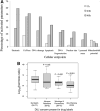A testing strategy to predict risk for drug-induced liver injury in humans using high-content screen assays and the 'rule-of-two' model
- PMID: 24958025
- PMCID: PMC5753582
- DOI: 10.1007/s00204-014-1276-9
A testing strategy to predict risk for drug-induced liver injury in humans using high-content screen assays and the 'rule-of-two' model
Abstract
Drug-induced liver injury (DILI) is a major cause of drug failures in both the preclinical and clinical phase. Consequently, improving prediction of DILI at an early stage of drug discovery will reduce the potential failures in the subsequent drug development program. In this regard, high-content screening (HCS) assays are considered as a promising strategy for the study of DILI; however, the predictive performance of HCS assays is frequently insufficient. In the present study, a new testing strategy was developed to improve DILI prediction by employing in vitro assays that was combined with the RO2 model (i.e., 'rule-of-two' defined by daily dose ≥100 mg/day & logP ≥3). The RO2 model was derived from the observation that high daily doses and lipophilicity of an oral medication were associated with significant DILI risk in humans. In the developed testing strategy, the RO2 model was used for the rational selection of candidates for HCS assays, and only the negatives predicted by the RO2 model were further investigated by HCS. Subsequently, the effects of drug treatment on cell loss, nuclear size, DNA damage/fragmentation, apoptosis, lysosomal mass, mitochondrial membrane potential, and steatosis were studied in cultures of primary rat hepatocytes. Using a set of 70 drugs with clear evidence of clinically relevant DILI, the testing strategy improved the accuracies by 10 % and reduced the number of drugs requiring experimental assessment by approximately 20 %, as compared to the HCS assay alone. Moreover, the testing strategy was further validated by including published data (Cosgrove et al. in Toxicol Appl Pharmacol 237:317-330, 2009) on drug-cytokine-induced hepatotoxicity, which improved the accuracies by 7 %. Taken collectively, the proposed testing strategy can significantly improve the prediction of in vitro assays for detecting DILI liability in an early drug discovery phase.
Figures



Similar articles
-
A high content screening assay to predict human drug-induced liver injury during drug discovery.J Pharmacol Toxicol Methods. 2013 Nov-Dec;68(3):302-13. doi: 10.1016/j.vascn.2013.08.001. Epub 2013 Aug 8. J Pharmacol Toxicol Methods. 2013. PMID: 23933113
-
In Vitro Drug-Induced Liver Injury Prediction: Criteria Optimization of Efflux Transporter IC50 and Physicochemical Properties.Toxicol Sci. 2017 Jun 1;157(2):487-499. doi: 10.1093/toxsci/kfx060. Toxicol Sci. 2017. PMID: 28369588
-
High lipophilicity and high daily dose of oral medications are associated with significant risk for drug-induced liver injury.Hepatology. 2013 Jul;58(1):388-96. doi: 10.1002/hep.26208. Epub 2013 May 27. Hepatology. 2013. PMID: 23258593
-
Control compounds for preclinical drug-induced liver injury assessment: Consensus-driven systematic review by the ProEuroDILI network.J Hepatol. 2024 Oct;81(4):630-640. doi: 10.1016/j.jhep.2024.04.026. Epub 2024 May 3. J Hepatol. 2024. PMID: 38703829
-
Drug Induced Liver Injury (DILI). Mechanisms and Medicinal Chemistry Avoidance/Mitigation Strategies.J Med Chem. 2020 Oct 22;63(20):11397-11419. doi: 10.1021/acs.jmedchem.0c00524. Epub 2020 Jun 19. J Med Chem. 2020. PMID: 32511920 Review.
Cited by
-
Comedications alter drug-induced liver injury reporting frequency: Data mining in the WHO VigiBase™.Regul Toxicol Pharmacol. 2015 Aug;72(3):481-90. doi: 10.1016/j.yrtph.2015.05.004. Epub 2015 May 16. Regul Toxicol Pharmacol. 2015. PMID: 25988394 Free PMC article.
-
Estimating drug-induced liver injury risk by in vitro molecular initiation response and pharmacokinetic parameters for during early drug development.Toxicol Res (Camb). 2023 Jan 9;12(1):86-94. doi: 10.1093/toxres/tfac083. eCollection 2023 Feb. Toxicol Res (Camb). 2023. PMID: 36866207 Free PMC article.
-
Drug-induced mitochondrial impairment in liver cells.EXCLI J. 2015 Dec 22;14:1297-9. doi: 10.17179/excli2015-764. eCollection 2015. EXCLI J. 2015. PMID: 26862331 Free PMC article. No abstract available.
-
Identification of average molecular weight (AMW) as a useful chemical descriptor to discriminate liver injury-inducing drugs.PLoS One. 2021 Jun 25;16(6):e0253855. doi: 10.1371/journal.pone.0253855. eCollection 2021. PLoS One. 2021. PMID: 34170966 Free PMC article.
-
Review of high-content screening applications in toxicology.Arch Toxicol. 2019 Dec;93(12):3387-3396. doi: 10.1007/s00204-019-02593-5. Epub 2019 Oct 29. Arch Toxicol. 2019. PMID: 31664499 Free PMC article. Review.
References
-
- Andersen ME, Krewski D. Toxicity testing in the 21st century: bringing the vision to life. Toxicol Sci. 2009;107:324–330. - PubMed
-
- Bleicher KH, Bohm HJ, Muller K, Alanine AI. Hit and lead generation: beyond high-throughput screening. Nat Rev Drug Discov. 2003;2:369–378. - PubMed
-
- Chen M, Vijay V, Shi Q, Liu Z, Fang H, Tong W. FDA-approved drug labeling for the study of drug-induced liver injury. Drug Discov Today. 2011;16:697–703. - PubMed
-
- Chen M, Zhang M, Borlak J, Tong W. A decade of toxicogenomic research and its contribution to toxicological science. Toxicol Sci. 2012;130:217–228. - PubMed
-
- Chen M, Borlak J, Tong W. High lipophilicity and high daily dose of oral medications are associated with significant risk for drug-induced liver injury. Hepatology. 2013a;58:388–396. - PubMed
Publication types
MeSH terms
Substances
Grants and funding
LinkOut - more resources
Full Text Sources
Other Literature Sources
Medical

